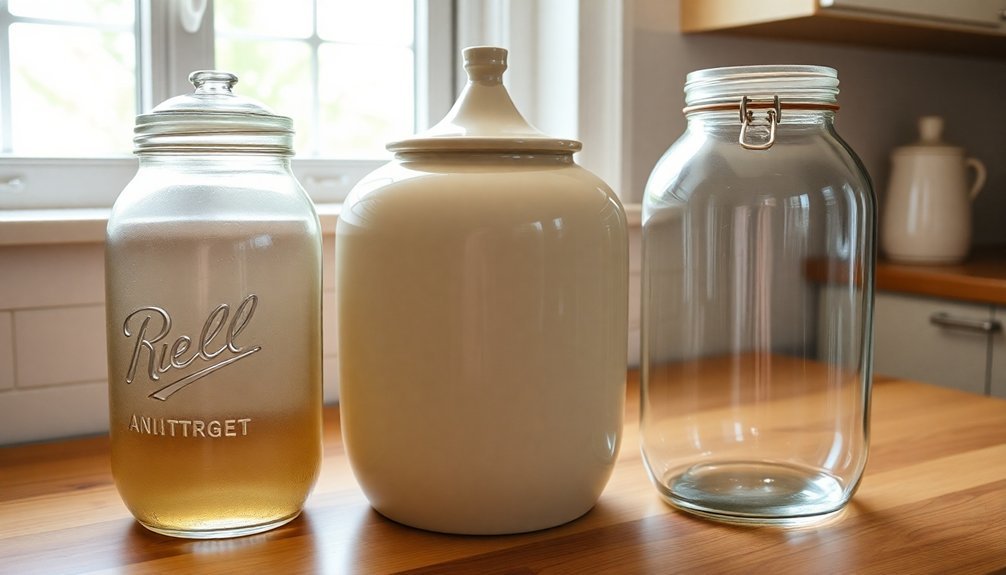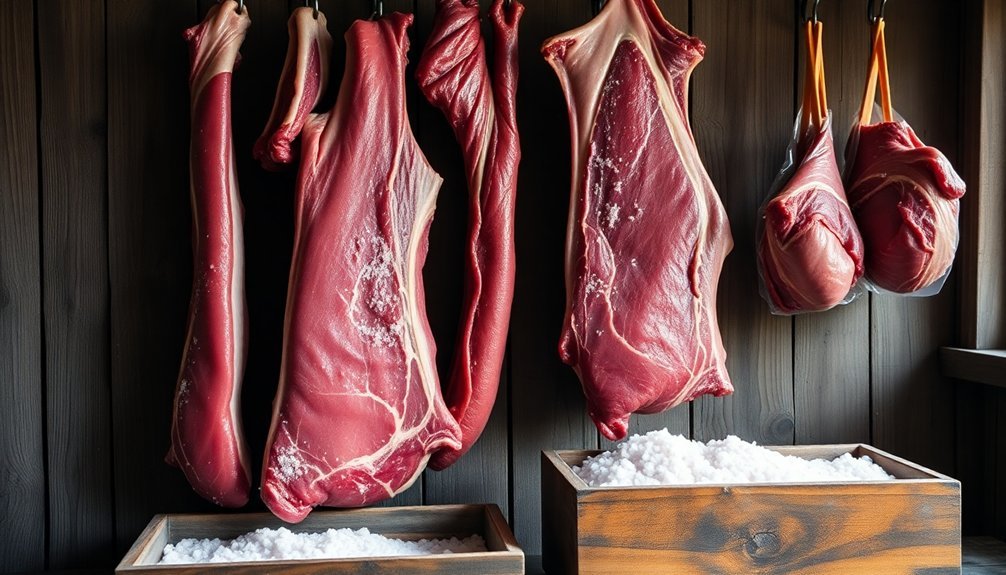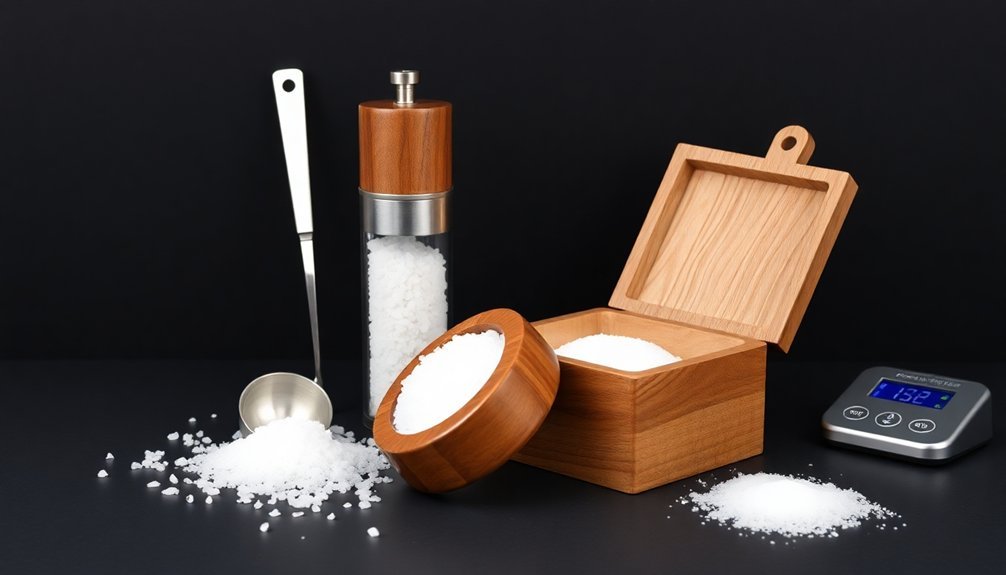When starting with home food preservation, you'll need reliable fermentation vessels that maintain proper conditions. Glass containers offer the ideal entry point since they're non-reactive, allow easy monitoring, and clean up effortlessly. Ceramic crocks work well for larger batches and provide excellent temperature stability through their thick walls. Stainless steel options give you durability and precision temperature control, while traditional wooden barrels can add complex flavors to specific ferments. For beginners, start with a glass vessel slightly larger than your batch size to accommodate expansion. Understanding your vessel options and their unique benefits will transform your fermentation journey.
Popular Glass Fermentation Containers

Glass fermentation containers stand as one of the most trusted choices for both novice and experienced fermenters. Made from non-reactive borosilicate glass, these vessels won't impart unwanted flavors or odors into your ferments.
You'll find them particularly convenient because they allow you to monitor your fermentation progress without opening the container.
Most glass fermenters come equipped with practical features you'll appreciate. You'll typically get a venting system in the lid that opens during fermentation and seals tight for storage, plus glass weights to keep your produce submerged. GEFU quality products have been trusted in kitchens worldwide for nearly 70 years.
Many models are stackable, saving valuable space in your refrigerator, and they're perfect for small-batch fermentation projects.
While you'll need to handle these containers with care due to their fragility, they're incredibly easy to clean and sterilize.
You might need to replace lids and gaskets periodically, and some jars require regular "burping" to release excess gases.
Keep in mind that narrow-mouth jars can make it challenging to pack larger vegetables, but the visual appeal and environmental friendliness of glass containers make them a worthwhile investment for your fermentation journey.
Traditional Ceramic Crock Benefits
While ceramic crocks may seem old-fashioned, they've remained a go-to choice for serious fermenters due to their superior environmental control. Their thick stoneware walls maintain stable temperatures, while the water-sealed moat creates an airtight vacuum that lets gases escape but keeps unwanted air out. The specialized ceramic vessels naturally enhance nutrient absorption during the fermentation process.
You'll find that these traditional vessels considerably reduce the risk of contamination while promoting the growth of beneficial bacteria like lactobacillus.
Key advantages that make ceramic crocks stand out:
- They create an ideal anaerobic environment through their water-sealed design, preventing surface molds and unwanted yeasts from developing.
- You'll get consistently moister results compared to jar fermentation, thanks to better temperature control and reduced evaporation.
- The design includes specialized weights that keep vegetables properly submerged in brine, ensuring uniform fermentation.
- They're perfect for larger batches, requiring minimal maintenance while delivering reliable results.
Whether you're making sauerkraut, kimchi, or even advanced ferments like miso, a ceramic crock offers nearly carefree fermentation with superior quality outcomes.
Its traditional design has proven especially valuable for households needing to produce considerable quantities of fermented foods.
Wooden Barrel Fermentation Methods

Wooden barrel fermentation carries forward an age-old tradition that's shaped the character of countless wines, whiskeys, and specialty beers. When you're using oak barrels, you'll benefit from their unique ability to allow micro-oxygenation while imparting complex flavors like vanilla, caramel, and spices through natural compounds.
To maintain your wooden barrel's integrity, you'll need to follow specific care protocols. Keep the barrel sealed, regularly check for leaks, and guarantee proper sterilization using Campden tablets. Proper chemical treatments are essential for maintaining food safety and preventing unwanted bacterial growth. If you notice shrinkage, soak the barrel in water to help the wood swell and maintain its seal.
| Barrel Type | Flavor Profile | Best Used For |
|---|---|---|
| American Oak | Strong vanilla, coconut | Bourbon, bold wines |
| French Oak | Subtle spice, tight grain | Fine wines, cognac |
| Hungarian Oak | Rich tannins, toasted notes | Red wines, brandy |
| Slovenian Oak | Gentle oak influence | White wines, sherry |
For best results, you'll want to roll your barrel periodically during fermentation to guarantee complete contact between the liquid and wood. Remember that wooden barrel aging isn't typically used for primary fermentation but rather for the maturation phase, which can span months or even years.
Modern Stainless Steel Options
Moving from traditional oak vessels to contemporary alternatives, stainless steel fermentation tanks offer unmatched versatility and control.
You'll find these modern vessels equipped with advanced temperature control systems, including integrated heating elements and cooling options that let you maintain precise fermentation conditions. Their corrosion-resistant properties make them ideal for handling acidic components in everything from wine to yogurt.
- You can easily clean and sanitize these vessels thanks to their smooth surfaces and weldless assemblies, making them perfect for both food and beverage fermentation.
- They're virtually indestructible compared to glass carboys, offering superior mechanical strength and pressure resistance.
- You'll appreciate the integrated monitoring systems that allow real-time temperature and pressure adjustments.
- Their versatility extends across multiple applications, from beer brewing to cheese making.
Whether you're fermenting condiments like vinegar and soy sauce or producing dairy products, stainless steel vessels give you complete authority over the process.
The 304 stainless steel construction, combined with features like domed bases for yeast flocculation and rotating racking arms, guarantees efficient and reliable fermentation every time.
Choosing Your First Vessel

Selecting your first fermentation vessel can feel overwhelming given the variety of materials and features available. For beginners, a glass vessel is your safest choice because it's non-reactive and lets you monitor your fermentation progress easily.
If you're starting with small batches, choose a vessel that's slightly larger than your intended batch size to accommodate expansion during fermentation.
You'll need to cover your vessel with a breathable material like a clean cotton cloth or coffee filter, secured with a rubber band. This setup allows proper airflow while keeping contaminants out.
Don't use wooden vessels for your first attempts, as they're harder to maintain and can harbor unwanted bacteria.
When selecting your vessel size, consider how much fermented food you'll realistically consume. While larger vessels might seem appealing, they can affect fermentation time and final flavors.
If you're planning to make kombucha or other continuous brews, look for a vessel with a food-grade spigot.
Remember that whatever vessel you choose should be easy to clean and sanitize between batches to prevent contamination and guarantee successful fermentations.
Vessel Maintenance Best Practices
Proper maintenance of your fermentation vessel goes far beyond basic cleaning. You'll need to establish a systematic approach that includes regular cleaning, inspection, safe chemical handling, and preventive measures to guarantee your vessel's longevity and peak performance.
1. Clean thoroughly after each use by first warming the tank with 90°C water to remove yeast residue, then apply brewery-approved cleaners and sanitizers.
Don't forget to use compressed air to remove residual CO2 before starting the cleaning process.
2. Perform regular inspections of all components, particularly seals, valves, cooling jackets, and temperature probes.
You'll want to calibrate your instrumentation annually and maintain proper tank pressure between 0.03 and 0.05mpa.
3. Handle chemicals carefully by following manufacturer guidelines for concentration levels.
Use alkaline solutions for organic matter and acidic solutions for inorganic substances, but never use abrasive materials that could damage the interior surface.
4. Protect your investment by installing the vessel on a stable, level surface, avoiding temperature extremes, and maintaining positive pressure during cleaning (0.01-0.04Mp).
When not in use, drain and clean both the vessel and connecting pipes to prevent buildup.
Temperature Control For Vessels

You'll need to keep a close eye on your ferment's temperature using either strip thermometers or probe sensors to guarantee ideal conditions throughout the process.
For cold storage control, you can convert a standard refrigerator or freezer into a dedicated fermentation chamber by adding an external temperature controller.
Whether you're using simple insulation methods or advanced cooling systems, maintaining consistent temperatures will greatly affect your fermentation's success.
Monitoring Your Ferment's Heat
Maintaining the right temperature during fermentation can make or break your final product. You'll need reliable monitoring tools to guarantee your ferments stay within the ideal temperature range. While basic thermometer strips can work for casual fermenters, more serious practitioners should consider using immersion probes or thermowells for precise readings.
- Mount a self-adhesive thermometer strip on your vessel's exterior for quick temperature checks, but remember they're less accurate than internal probes.
- Install a thermowell through your vessel's stopper to house temperature-sensing probes, giving you accurate readings without contamination risks.
- Use dual-sensor setups to monitor both air and wort temperatures, helping you adjust for temperature differentials between the vessel wall and its contents.
- Consider LCD thermometers with external displays for easy monitoring without disturbing your ferment.
You'll want to check temperatures consistently and make gradual adjustments when needed. If you're using external sensors, account for the temperature differential between the sensor location and the actual ferment.
For the most precise control, pair your monitoring tools with a dual-stage temperature controller that can both heat and cool your vessel as needed.
Cold Storage Solutions
Temperature control systems are the backbone of successful fermentation, offering various solutions to maintain ideal conditions for your vessels. You'll find several effective options, from basic external cooling methods using ice baths to sophisticated glycol chillers that provide precise temperature regulation.
For home fermentation, you can start with simple solutions like self-adhesive thermometer strips and portable cooling units. If you're looking for more control, consider investing in digital temperature controllers that maintain a consistent 2 to 8 degree Fahrenheit range. These controllers work well with cooling coils and heating units to provide dual-stage temperature management.
Don't overlook the importance of proper insulation and sealing for your fermentation vessels. You'll want to use thermowells to protect your temperature probes while ensuring accurate readings.
For larger operations, refrigerated containers offer precise control from +30°C to -40°C.
When selecting your cold storage solution, consider factors like accessibility, vessel compatibility, and scalability. You can opt for cost-effective options such as used refrigerators or glycol systems.
Remember to monitor your fermentation progress regularly and adjust your temperature control system as needed to prevent spoilage and maintain product quality.
Frequently Asked Questions
Can I Use Antique Fermentation Vessels Found at Flea Markets?
You shouldn't use antique fermentation vessels from flea markets, as they may contain toxic materials like lead, harbor harmful bacteria in hidden cracks, and lack proper safety features for modern fermentation practices.
How Do Different Vessel Materials Affect Fermentation Time?
Your fermentation time will vary by vessel material: stainless steel offers consistent timing, glass is standard, wooden vessels slow the process due to temperature fluctuations, while plastic may speed fermentation through oxygen permeability.
What Emergency Repairs Can Fix a Leaking Fermentation Vessel?
You can quickly fix a leaking fermentation vessel by tightening connections, replacing worn seals, or applying food-safe sealants. Don't attempt welding repairs yourself – it's best to consult a professional for serious leaks.
Are Uv-Protective Fermentation Vessels Worth the Extra Cost?
Yes, UV-protective vessels are worth your investment. You'll get better fermentation results, reduce spoilage risks, and save time on covering or relocating your ferments. They're especially valuable if you're fermenting regularly.
Can Fermentation Vessels Be Safely Stored Outdoors Between Uses?
You shouldn't store fermentation vessels outdoors, even with a tarp. They'll risk damage from weather, temperature changes, and contamination. If you must, make sure they're thoroughly cleaned, completely dry, and well-protected.
In Summary
You've now got a solid understanding of fermentation vessel options, from classic crocks to modern stainless steel. Remember, you don't need to start with an elaborate setup – a simple glass jar can produce great results. Keep your vessels clean, monitor temperatures carefully, and you'll be fermenting successfully in no time. As you gain confidence, you'll discover which containers work best for your specific needs.





Leave a Reply